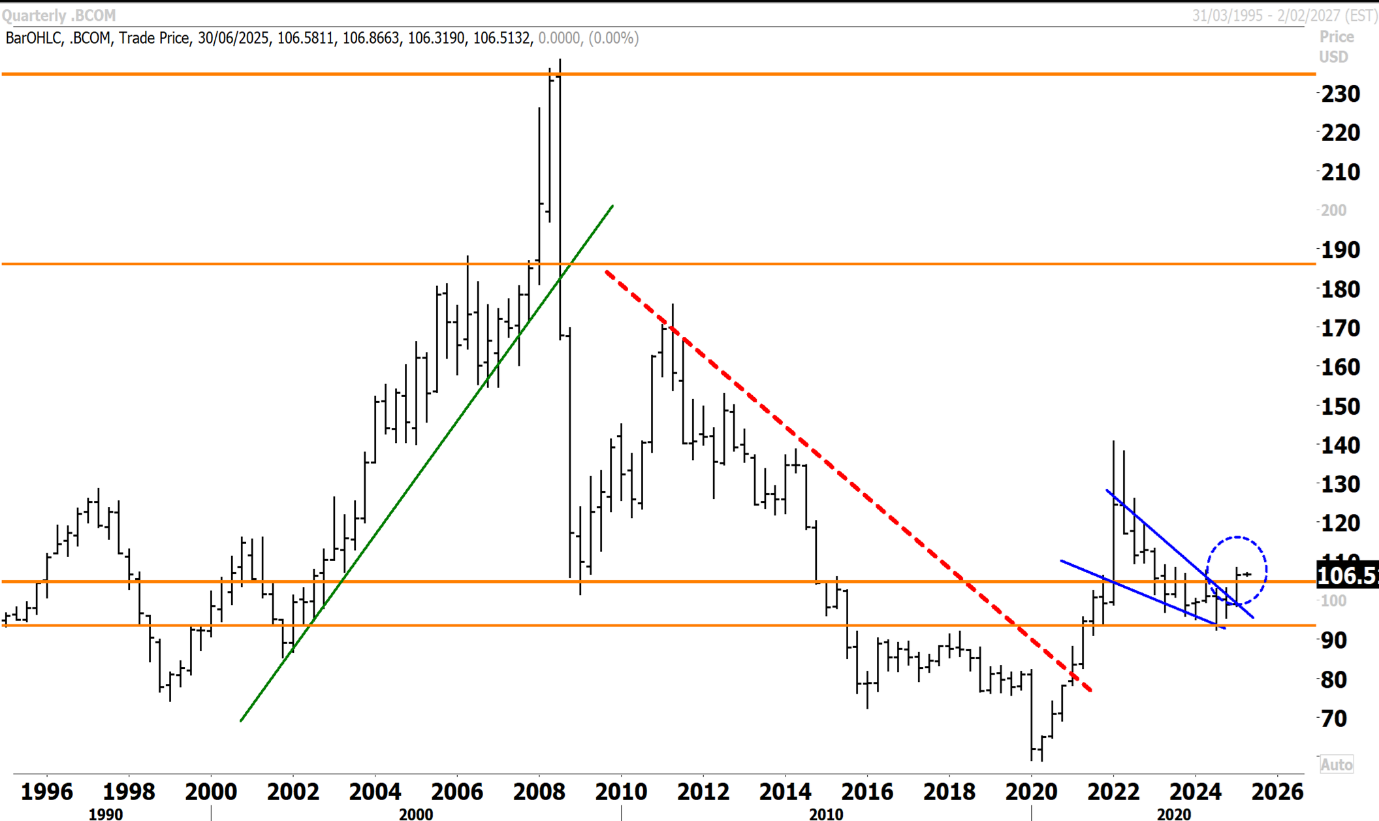
After President Trump unveiled the most far-reaching anti-trade policies in over 100 years, financial markets came under significant pressure. The tariffs imposed were much worse than feared, which global leaders universally condemned. Wall Street benchmarks lost over 5% with any company exposed to the tariffs taking big hits. The US dollar plunged while bonds rallied as recessionary risks increased.
Volatility surged 25% but the VIX is yet to take out the March highs. Many economists downgraded US growth forecasts. Canadian Prime Minister Mark Carney said the US had abandoned its historic role as a champion of international economic cooperation. “The global economy is fundamentally different today than it was yesterday”.
The US vs the rest of the world.
After President Trump unveiled the most far-reaching anti-trade policies in over 100 years, financial markets came under significant pressure. The tariffs imposed were much worse than feared, which global leaders universally condemned. Wall Street benchmarks lost over 5% with any company exposed to the tariffs taking big hits. The US dollar plunged while bonds rallied as recessionary risks increased.
Volatility surged 25% but the VIX is yet to take out the March highs. Many economists downgraded US growth forecasts. Canadian Prime Minister Mark Carney said the US had abandoned its historic role as a champion of international economic cooperation. “The global economy is fundamentally different today than it was yesterday”.
Oil plunged not just on higher risks of slowdown, but as OPEC signalled it would raise future production. Gold made new record highs above $3170oz while other precious metals retreated. International stocks declined, but notably to a much lesser extent than US benchmarks. Trade war tensions dialled up with many countries threatening to reciprocate against the US.
The S&P 500 shed -4.84% to 5,396, taking out the March lows in the process. The Nasdaq Composite slumped -5.97% while the Dow Jones fell -3.98%. The Russell 2000 was hard hit, losing -6.6%. Investors fled from risky assets, seeking the safety of government bonds and gold. Some of the sectors that bucked the trend were telcos, tobacco, supermarkets, fast food operators such as McDonalds and gold stocks. Bank stocks got hammered. The VIX jumped 33% to challenge the March highs.
Bonds rallied with yields falling sharply across the curve. The yield on the US2yr dropped 16 bps to 3.71% and the 10yr, 9 bps to 4.06%. Investors are flocking to bonds as a safe haven as recessionary risks dialled up.
Commodities came under pressure led by a 7% fall in oil prices on concerns global growth will slow, but also OPEC plans to increase production sharply. WTI crude fell 6.8% to $66.70 while Brent was off 6.6%. Gold made intraday highs above $3160 but eased throughout the session. Copper fell 4.5% while silver declined 6% to $31.75. Crytpo fell 5%. Soft ag held up much better with only modest declines.
Market Insights
Futures markets are pricing in expectations of more rate cuts to come from the Federal Reserve (up to four this year) commencing in June, but an inflationary shock around the tariffs could block this. Trump will almost certainly dial up pressure on Fed Chair Jerome Powell to cut rates, but I see the man holding the line and resisting this if inflationary pressures intensify. Powell will not want his legacy to be labelled another “Arthur Burns”. Arthur Burns buckled under political pressure and cut rates in the 1970s which set off inflation.
The key labour market data due later and Fed Chair Jerome Powell’s speech to follow shortly after could offer crucial insights into the US economy’s health and the future path of interest rates.
The market is not only fearful of a new economic reality but also concerned about how other countries will react to the Trump tariffs. The US does not hold all the cards with many companies exposed to the seismic changes in trade policy. The door is still open for the White House to dial back the harsh tariffs, but for now, uncertainty prevails regardless of whether negotiations play out over the coming months. The upcoming reporting season is also shaping up to be defining for the stock market, despite valuations coming down.
Global opposition to the US tariffs will likely intensify with many global consumers likely to boycott American products. (We have already seen this with vandalism targeting Tesla cars around the world). Several countries vowed retaliation to the measures including the European Union (which faces a 20% duty) and China. South Korea, Mexico, India and several other trading partners said they would hold off for now as they seek concessions before the targeted tariffs take effect on April 9. The coming days are going to be volatile.
In terms of the technical setup for the S&P500, the March lows at 5,500 were breached on Thursday to close on the intraday lows. The support level at 5,200 is now within site as the next important line of defence. The correction that is unfolding clearly has further to go, but a bear market (defined by the S&P500 being down 20% has yet to be confirmed). The big supports at 5,200 and 4,800 still look to hold in the near term, which favours a coming rebound if the tariffs were to be dialled back, but this is by no means a certainty.

Dollar Index
Turning to the US dollar, I maintain a high conviction call the US dollar will enter a bear market this year. Arguably, this is already underway, although the DXY still remains rangebound and is yet to show definitive signs of breaking down on the charts. The dollar seems to be behaving very differently this year which is a telling sign. Typically, during market selloffs the dollar would receive a bid as a safe haven currency.
March saw the exact opposite occur as gold, yen, euro all held outperformed against the greenback. The dollar, in an environment where it should be acting like a safe haven, is clearly not. I think there are deep seated reasons for this change. Firstly, Trumps escalating tariffs and bid to roll back decades of globalization is destroying confidence and pushing capital away from the dollar.
Since the Bretton Woods accord that followed WW2, the US dollar has been at the heart of the world financial system for eight decades as the reserve currency. But this is now unravelling, with longer term implications stemming from Trump’s trade policies which are increasingly isolationist – and not conducive to a reserve currency.
The dollar began weakening markedly not long after Trump assumed office and by mid-March, speculative positions swung to the bearish side. (JP Morgan pivoted last month to the bearish camp after being bullish for a number of years). A recession (should it occur in the US) would further undermine the dollar and accelerate debasement.
The dollar still remains solidly entrenched as the reserve currency. The majority of central banks still hold the bulk of reserves in dollars and use them to still purchase most commodities such as oil. However, the disruption to global trade and tariffs could accelerate the de-dollarisation trend. Trump’s actions are rekindling long-simmering discussions about whether overseas governments will accelerate efforts to lessen reliance on the dollar.
In terms of the big picture technical setup for the Dollar Index on the 30 year chart below the pattern is still bullish. The Dollar Index remains above the primary uptrend and key support at 100. However a breakdown below the primary uptrend would in my view signal a bear market. At the last peak of US exceptionalism back in 2000 (which coincided with the height of the dotcom bubble), the Dollar Index hit a record high at 120, only to fall over 40% in the eight years that followed through to 2008. A double bottom was then confirmed in 2012, which coincided with the peak of the last gold bull market.

Trump has said he wants to maintain the dollar’s central role globally, and last year even threatened to retaliate against any country that tries to decouple trade from the US currency. But he also said during his campaign that he’d welcome a weaker dollar to make the US more competitive. You cant have your cake and eat it to.
Carpe Diem
Sign up to receive full reports for
the best stocks in 2025!
Where to Invest in 2025?
The market is full of opportunities—but which stocks will deliver real wealth-building potential?
At Fat Prophets, our expert analysts uncover the best Australian and global stocks to help you stay ahead of the curve. Whether you’re looking for growth, income, or diversification, our carefully curated portfolio gives you access to high-conviction stock recommendations backed by deep research and proven insights.
Subscribe now to get full reports of these stocks and get ready for the next big opportunities!
Over 25,000 customers worldwide
Need a try? You’re first-time customer?
Enjoy our Welcome Gift with $500 OFF your Membership
Use code: FPWELCOME
FAQ’s
How much does a Membership cost?
We have a number of Membership options for the DIY investor. Our research services cover individual stock opportunities in Australia, as well as the UK, global markets, and a sector-specific report focussing on the mining space. Annual Membership prices start at $1095.
Do you offer execution services?
No we do not, and our research is independent in the sense that we are not conflicted by operating broking services alongside them. We also do not offer ‘sponsored research’ and are not financially incentivised by any of the companies that we recommend to Members.
Can I access any special offers?
Our introductory joining offers relate only to new Members. We do however offer ‘early bird’ discounts to existing Members who renew in advance of their Membership expiring.
Can I get tailored financial advice?
Our research products are ‘general advice’ in nature only, however we do categorise all our recommendations by the level of risk appetite which we believe is involved. Members looking for more direct advice can also make an inquiry to our wealth management team which offers a separately managed accounts service.
Do you offer a Money-Back guarantee?
Yes we do. Fat Prophets offers a 100% money back guarantee on annual subscriptions within 30 days of taking out a Membership.






